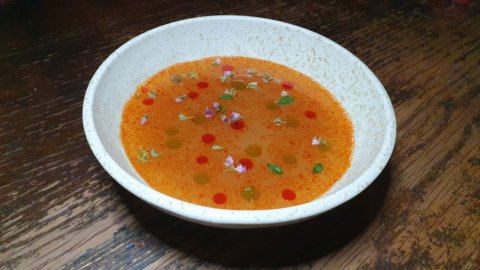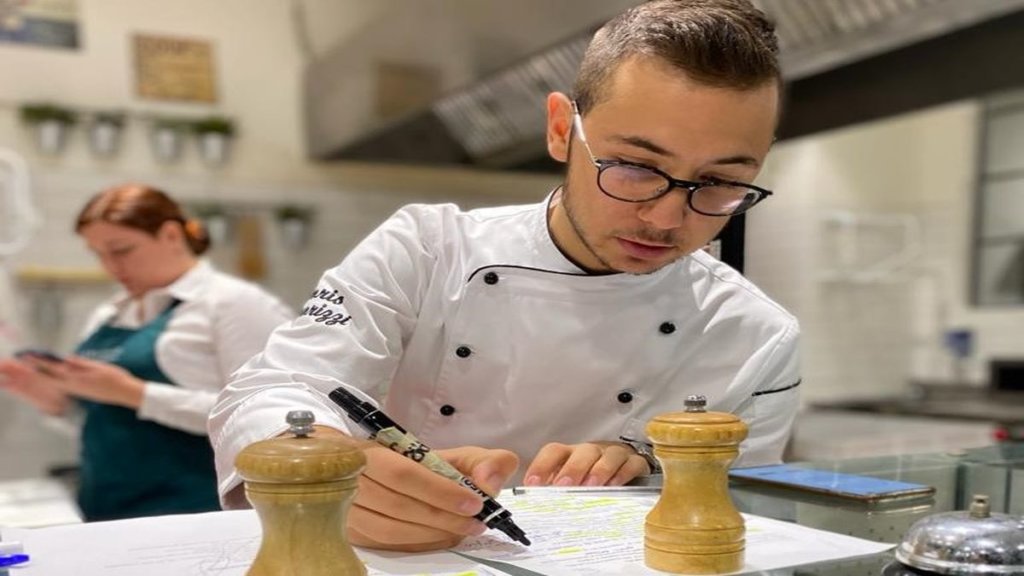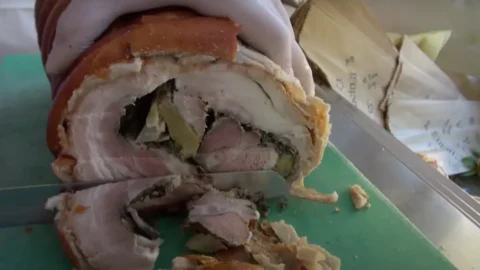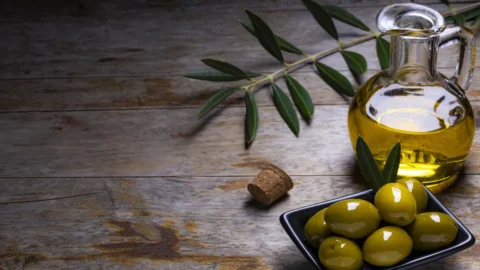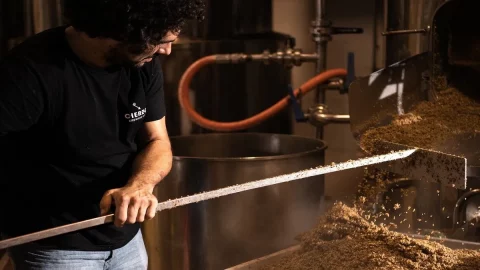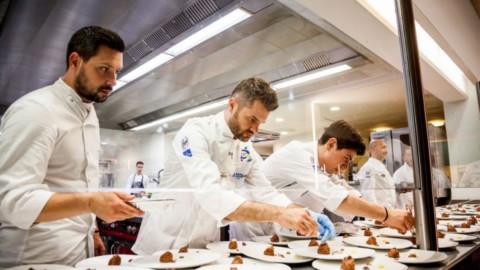Seeing him like this, with that slightly dreamy, almost helpless air, an uncertain beard framing his face, rimmed glasses, you remember Harry Potter. But woe to be deceived by appearances. In reality, behind this very young chef there is a real war machine that knows no obstacles even if it occurs to you that he must have some hidden magical art.
It cannot be otherwise explained how someone who remembers only the fact of wandering around in the kitchen next to his grandmother for the satisfaction of salting pasta or beating eggs as his gastronomic youthful steps finds himself at the age of only 15 carrying out an internship in the kitchens of the authoritative Grand Hotel et de Milan, and a year later, at the age of 16, landed at the uncompromising restaurant Carlo Cracco, and from there enter the three-starred and very rigorous kitchens of Enrico Crippa of "Piazza Duomo" in Alba, and then, without taking a break, arrive with a lot of awe, but a great will to go on … and beyond, in Montecarlo at the court of the fantastic Le Louis XV by Alain Ducasse, supreme chef and entrepreneur, at the head of an empire with 1400 employees, restaurants around the world on which he has placed 25 Michelin stars. And since Europe was close to fly to Bangkok at Gagan Anand in what is counted as the fourth best restaurant in the world for The World's 50 Best restaurants and four times better than Asia to enter the dimension of a kitchen that knows how to bring the meaning and treatment of pure matter to extreme synthesis with innovative cooking systems.
And then again return to Paris in the refined Yannick Alléno's restaurant in the heart of the Champs-Elysées, where "cooking takes on forms of art", to quote the judges of the Michelin Guide who have repeatedly rewarded it with eight stars. Ours wants to try new areas, study and spread new food ideas, in short, jump over the fence. Ed so here he is at the same time assuming the guise of accredited gastronomic disseminator for the channel The Food Evolution in partnership with Promotion magazine, as a gastronomic consultant for innovation projects and revision of the gastronomic offer including Red Feltrinelli, as an executive trainer for various types of food companies, including Carrefour for some bar outlets, as a consultant for some important companies on vacuum cooking, by the co-founder of SuiteFood, a start-up created to introduce the Asian culture that is so fashionable among health-conscious people into Italian homes.
Now with a life always lived with the pedal pushed on the accelerator, passing through the great temples of world catering, one imagines that Loris Caporizzi – finally we reveal his name with a magic stroke just to stay on the subject – stops in a prestigious venue for putting into practice all that he has acquired around the world and enjoying the pleasures of fame among unrivaled dishes that are the expression of the highest international cuisine such as a Roannaise-style duck pie and foie gras, or a Blanquette di veau all' ancienne, at Bocouse, or an Agneau des Alpilles et courgettes trompettes caillé de brebis/tomates at Ducasse, or a The Hen and the Egg a la Rene Redzepi or what a Pork Bao, Momofuku, a la David Chang or a Duck with Daikon and Plum a la Daniel Humm.
None of that. In Loris Caporizzi there is always that pedal pushed on the accelerator of his kitchen considered as a Ferrari in an unbridled race or rather as a spacecraft launched into space in search of new boundaries.
The world is hungry, In less than a century the Earth has gone from 2 billion human beings to almost 8 billion, and the seas and land will not be able to bear the impact of future generations, safeguarding environmental sustainability and nutritional properties if runs for cover in time. For our Chef-Harry-Potter, human behavior is not sustainable for our planet in the long term and the basic problem of nutrition finds in the cooks and in the kitchen a pivotal role and an objective responsibility in study and enhance ingredients, techniques and processes that minimize the environmental impact of food consumption. directing future choices of food habits.
At the Lagrange Hotel Institute, three years ago, he surprised everyone, as is his habit, with a 150-page thesis "The Garden of the Future" which enhances the gastronomic goodness and the nutritional function of insects, a very rich source of proteins/amino acids, of essential minerals for the human body and of a broad spectrum of B vitamins, with a lot of tasting that also receives praise. In 2018, Europe launched a new regulation on the so-called Novel Food, which include the insects among the new foods of the future, ready to be produced and sold also in Italy. A novelty for us but not for the world, above all in the countries of Africa, Asia and South America where there is a considerable consumption of insects - such as beetles (31%), caterpillars (18%) and bees, wasps and ants (14%), crickets, grasshoppers and locusts (10%).
Like it or not at the moment the idea is the new trend of the future food. Loris Caporizzi champions it, as usual anticipating the times. And in order not to remain only in theory but to move on to facts, Caporizi takes advantage of the free time in which even a hyperactive person like him is condemned by the Pandemic to publish a book that makes noise “Incredible Insects (watch out for capital E ed.) Entomophagy in the West – A food between past and future ” affordable on Amazon also in Kindle format and an English edition is already announced.
Does anyone turn up their noses? Caporizzi ensures that «Those who taste fried grasshoppers seasoned with paprika and sea salt will hardly stop eating them, many associate them with the crispy skin of a roast chicken». On the other hand already a great food critic like Luigi Veronelli he had in the past exalted the goodness of some insect-based dishes. She had done it with a little book “It is forbidden to forbid. Thirteen recipes for various disgusts” published by Elèuthera in which she provided indications on how to eat grasshoppers, locusts, silkworms, larvae, cicadas which, although considered delicacies in other cultures, were instead more or less disgusting for the European food imagination.
And then to think about it here too the Sardinian Casu marzu with its worms in Sardinia made history, and those monstrous Percebes, species of ungulate dragons that arrive from the waters of the Atlantic on gourmet tables or crabs or mantis shrimps is only visible they are so reassuring but yes to the taste.
And so if our tables are destined to be invaded by insects and worms in the future, at least it is cooked with the school of a great chef trained in the great masters of the kitchen.
For the readers of Foodfirstonline, chef Loris Caporizzi has chosen a recipe from his book "Incredible insects". All that remains is to try
The recipe: Cricket and grasshopper consommé
Ingredients
For the consomme:
200g of live grasshoppers, 30g of extra virgin olive oil, 70g of shallots, 120g of tomato, 150g of fennel, 50g of ground crickets, 70ml of white wine, 8g of tomato concentrate, 2g of black peppercorns, 800ml of cold water
For Sichuan oil:
15g Sichuan pepper, 75g shallots, 300g corn oil, 25g soy sauce, 25g toban djan
(bean and chilli paste), 15g of granulated sugar, 3g of salt, 40g of dehydrated chilli flakes, 1g of 5-spice powder
For the coriander oil:
100g of fresh coriander, 250g of grape seed oil
For the garnish:
3g of green shiso flowers
Preparation
To prepare the consommé, put the grasshoppers in the freezer for about an hour to make sure they inhibit movement before opening the package. Cut the fennel and shallot into coarse julienne strips and the tomato into slices.
In a saucepan, heat some olive oil, insert the grasshoppers and leave to brown.
Then add the vegetables, tomato paste and peppercorns and brown everything well before deglazing with white wine.
When the wine has evaporated, add cold water and cricket powder. Mix well and bring to a boil. Leave to cook for 25 minutes and turn off the heat.
Pass the broth through a fine muslin and, once filtered, return to the heat and boil until it reduces by a third.
To make the Sichuan oil, dry toast the pepper and grind it in a mortar until it is reduced to a fairly fine powder. Then proceed to chop the shallot.
Heat 50g of the oil in a pan and add the shallots, cook for about five minutes, until it starts to brown and is completely cooked. Deglaze with soy sauce and let it evaporate for a minute before adding the toban djan. Simmer over medium heat for 3-4 minutes before adding the sugar and salt.
Then pour in the chilli flakes and add the remaining oil. Then add the crushed Sichuan pepper and the 5-spice powder. Cook for another 3 minutes.
Transfer to an airtight jar and leave to rest for a few days before using.
For the coriander oil, peel the coriander by removing the stems and place it in the glass of a Termomix.
Heat the oil in a pan to around 70°C.
Pour it over the coriander, set a temperature of 65°C and blend on high speed for 1 minute before lowering to medium speed and blending for a further 6 minutes.
Strain through a fine mesh strainer into a container set in ice cold water.
Once cooled, place in the refrigerator for 6 hours in a tall, narrow container. Separate the green oil from the deposit that has accumulated at the bottom and transfer to a baby bottle for use.
Plating
Pour the hot consommé and garnish with drops of the two colored oils. Sprinkle with shiso flowers and serve.

